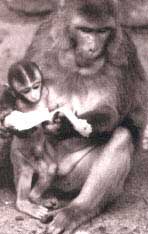No monkey business, this
 MONKEYS have an amazing knowledge of medicinal plants. When they fall ill or get hurt they cure themselves by eating plants commonly found around them. A long-term study undertaken by the author in the 1990s in Delhi to determine the effects of food on the health of monkeys, brings to light the exceptional knowledge possessed by monkeys about the therapeutic value of plants (Primate Report 4Z April 1995).
MONKEYS have an amazing knowledge of medicinal plants. When they fall ill or get hurt they cure themselves by eating plants commonly found around them. A long-term study undertaken by the author in the 1990s in Delhi to determine the effects of food on the health of monkeys, brings to light the exceptional knowledge possessed by monkeys about the therapeutic value of plants (Primate Report 4Z April 1995).
The rhesus macaque (Macaca mulatta) - easily visible near temples, in urban forests and even on rooftops - is the most widely distributed non-human primate in India. The rhesus population in the country if classified by their proximity to human beings, would fall in two broad categories; the forest rhesus and human-habitation rhesus. The forest monkeys depend on a wide range of natural vegetation for their food, which in the case of human habitation monkeys is replaced largely by foods consumed by human beings.
Of Delhi's total geographical area of 1,483 sq kin, only six per cent is covered by natural forests on the Aravalli ridge. However, there are over a hundred colonies in Delhi where monkeys have made their homes. The study on monkeys in human habitation was conducted in Sanjay Vihar, a colony near Tughlakabad in south Delhi.
Tughlakabad has high voltage electric wires overhead, stretching between the poles. juvenile monkeys play on these wires arid very often get electrocuted. Mostly, they die instantly but in one instance, a juvenile survived the electrocution. However, his left lower arm was charred. In the course of the following week, the monkey ate only the leaves and fruits of the neent (Azadirachia indica) tree. After one week, when he came down his lower arm had got severed and the wound at the point of electrocution was still raw. For the next month, this juvenile was seen applying his own saliva on the wound and eating the tender leaves, branches and flowers of the kethri (Sonchus arverns) tree at least 15 times a day. At the end of the month, he had recovered fully.
The writer's observations of the eating habits of sick and injured monkeys since this incident, has led to the identification of 10 medicinal plants used by the sprightly primates. It was seen that during mating season, the tubers of the barbunda (Oxystelma secamone) are eaten by the males. It is possible that the tuber affects the potency of the animals. Aggression and confrontation amongst the males are common; very often, it leads to injuries. The wounded monkeys have been observed to be eating the buds of akh (Calotropis gigantea); they also apply the milky secretion from the branches of this shrub on their bleeding parts. This leads to coagulation of blood and eventually stops the bleeding.
By the end of the mating season, 80 per cent of the females between the ages of three-and-a -half to 15 years become pregnant. A major part of their natural diet comes from the tamarind tree (Tamarindus indica); its leaves, bark and fruits are consumed in large amounts. During the early lactation period, the tender brownish-pink leaves of the peepul (Ficus religiosa) tree are much sought after by the new mothers.
The monkeys living around human habitations face another unique problem: that of unfamiliar foodstuff. Items of normal human consumption, like paranthas (bread made of wheat flour and oil) or chocolates, sometimes find their way into the animals' diet. Eating such food very often leads to fits of vomiting and diarrhoea in them. But the animals know how to cure themselves. After vomiting, monkeys have been observed eating dhoob ghas tender grass blades and their white shoots. During diarrhoea, ghokru (Pedaliurn murex) fruits are consumed. Monkeys having blisters in their mouth eat the resin secreted by kikar (Accacia arabica). If they get feverish, they consume the pods of hulhul (Cleome gynandra), while monkeys racked by coughing eat the leaves of the bansa (Adhatoda vestira).
Nutrient requirements of these animals are similar to that of humans. Besides carbohydrates, proteins, fibres and vitamins, primates need 22 minerals for their healthy existence. A low magnesium diet can lead to cancer. Higher content of silicon in diet can lead to blood cancer. Low selenium, manganese and chromium content, on the other hand, can result in heart attack, while a low cobalt level leads to rapid weight loss. Monkeys in the wild do not suffer from heart attack, blood cancer or diabetes probably due to their dependence on natural food.
Some other studies have also pointed out that animals know more than humans about the plants that abound around them. Bears chew the root of the lingusticum (kath) and spread its juices on their bodies. Chimpanzees have been known to consume aspilia - known for its antifungal, antiviral and antiparasitic properties - in the mornings.
Related Content
- Major blow to Kenya’s tourism as fifteen baboons killed every day on Northern corridor
- Body Shop announces £2m 'bio-bridges' scheme to protect endangered rainforest wildlife
- A major concern’: plantation-driven deforestation ramps up in Borneo
- Marauding monkeys to now face bullets in Shimla
- Extinction of monkeys, birds could lead to more severe climate change
- 25 primates on endangered species list
